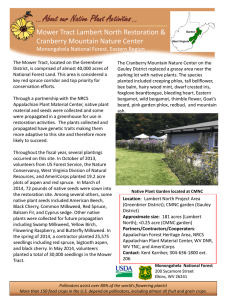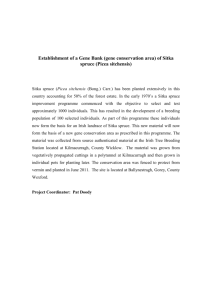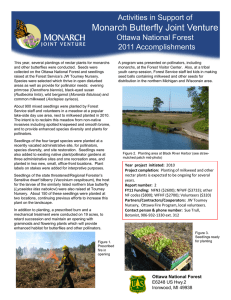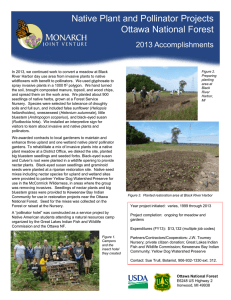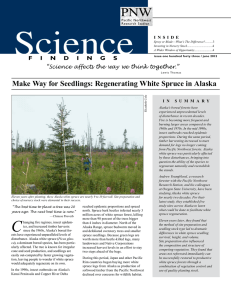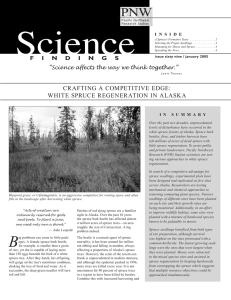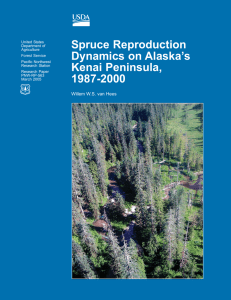Stop 2: Forest Regeneration Research and Demonstration Site at Fort Richardson, Alaska:
advertisement
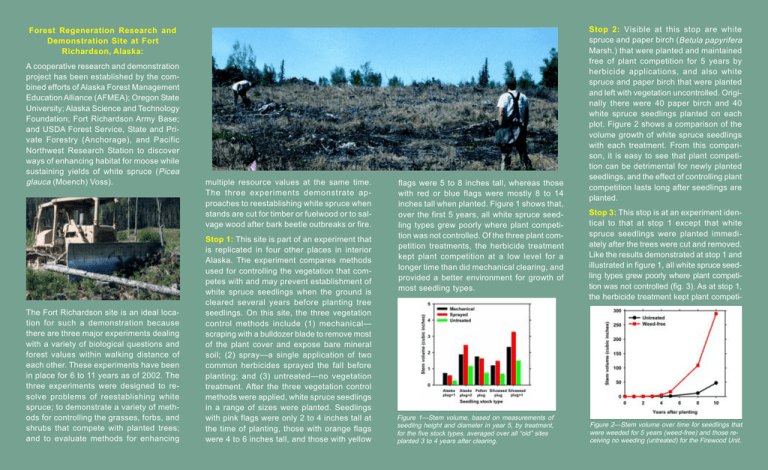
Forest Regeneration Research and Demonstration Site at Fort Richardson, Alaska: A cooperative research and demonstration project has been established by the combined efforts of Alaska Forest Management Education Alliance (AFMEA); Oregon State University; Alaska Science and Technology Foundation; Fort Richardson Army Base; and USDA Forest Service, State and Private Forestry (Anchorage), and Pacific Northwest Research Station to discover ways of enhancing habitat for moose while sustaining yields of white spruce (Picea glauca (Moench) Voss). The Fort Richardson site is an ideal location for such a demonstration because there are three major experiments dealing with a variety of biological questions and forest values within walking distance of each other. These experiments have been in place for 6 to 11 years as of 2002. The three experiments were designed to resolve problems of reestablishing white spruce; to demonstrate a variety of methods for controlling the grasses, forbs, and shrubs that compete with planted trees; and to evaluate methods for enhancing multiple resource values at the same time. The three experiments demonstrate approaches to reestablishing white spruce when stands are cut for timber or fuelwood or to salvage wood after bark beetle outbreaks or fire. Stop 1: This site is part of an experiment that is replicated in four other places in interior Alaska. The experiment compares methods used for controlling the vegetation that competes with and may prevent establishment of white spruce seedlings when the ground is cleared several years before planting tree seedlings. On this site, the three vegetation control methods include (1) mechanical— scraping with a bulldozer blade to remove most of the plant cover and expose bare mineral soil; (2) spray—a single application of two common herbicides sprayed the fall before planting; and (3) untreated—no vegetation treatment. After the three vegetation control methods were applied, white spruce seedlings in a range of sizes were planted. Seedlings with pink flags were only 2 to 4 inches tall at the time of planting, those with orange flags were 4 to 6 inches tall, and those with yellow flags were 5 to 8 inches tall, whereas those with red or blue flags were mostly 8 to 14 inches tall when planted. Figure 1 shows that, over the first 5 years, all white spruce seedling types grew poorly where plant competition was not controlled. Of the three plant competition treatments, the herbicide treatment kept plant competition at a low level for a longer time than did mechanical clearing, and provided a better environment for growth of most seedling types. Figure 1—Stem volume, based on measurements of seedling height and diameter in year 5, by treatment, for the five stock types, averaged over all “old” sites planted 3 to 4 years after clearing. Stop 2: Visible at this stop are white spruce and paper birch (Betula papyrifera Marsh.) that were planted and maintained free of plant competition for 5 years by herbicide applications, and also white spruce and paper birch that were planted and left with vegetation uncontrolled. Originally there were 40 paper birch and 40 white spruce seedlings planted on each plot. Figure 2 shows a comparison of the volume growth of white spruce seedlings with each treatment. From this comparison, it is easy to see that plant competition can be detrimental for newly planted seedlings, and the effect of controlling plant competition lasts long after seedlings are planted. Stop 3: This stop is at an experiment identical to that at stop 1 except that white spruce seedlings were planted immediately after the trees were cut and removed. Like the results demonstrated at stop 1 and illustrated in figure 1, all white spruce seedling types grew poorly where plant competition was not controlled (fig. 3). As at stop 1, the herbicide treatment kept plant competi- Figure 2—Stem volume over time for seedlings that were weeded for 5 years (weed-free) and those receiving no weeding (untreated) for the Firewood Unit. tion at a lower level for a longer time than did mechanical clearing and provided a better environment for most seedling types. White spruce seedlings are growing faster where they were planted immediately after clearing the site rather than waiting for several years and allowing competing vegetation to become established (fig. 3). Figure 3—Stem volume, based on measurements of seedling height and diameter in year 5 by treatment, for the five stock types, averaged over all “new” sites planted within the first year after clearing. Stop 4: This stop is at an experiment, started in 1993, that compares various treatments designed to produce multiple resource values at the same time. The ultimate goal of these treatments is to provide fuelwood, produce white spruce timber, and create productive habitat for moose. Four vegetation management treatments are demonstrated: (1) untreated—no vegetation treatment; (2) broadcast spraying—a single broadcast application of two common herbicides sprayed in the fall before planting; (3) strip spraying—a single application of an herbicide sprayed along planting rows just be- fuelwood, white spruce timber, and productive habitat for moose can be produced simultaneously. More information on these experiments may be obtained from the USDA Forest Service, State and Private Forestry, 3301 C St., Suite 522, Anchorage, AK 99503. Phone: (907) 743-9455. or Andrew Youngblood, Pacific Northwest Research Station, 1401 Gekeler Lane, LaGrande, OR 97850 Phone: (541) 962-6530 fore planting; and (4) mechanical clearing— scraping with a bulldozer blade to remove most of the plant cover and expose bare mineral soil. Paper birch, willow ( Salix species), and several sizes of white spruce seedlings were planted after each treatment. Wherever the site was severely disturbed, as on plots that were mechanically cleared, abundant paper birch seeds that came from adjacent mature trees germinated. Planted paper birch seedlings also survived reasonably well, but almost all paper birch were heavily browsed and have grown little in height for several years. Willows that were planted also were browsed, indicating that both of these species are part of productive habitat for moose. At this site, we have learned that small white spruce seedlings may need substantial control of competing vegetation if they are to survive, yet large seedlings may tolerate quite a bit of cover. Reduction of cover also improves growth of all stock types. Of the plant-competition-control treatments, herbicide application has created the best environment for growth of all tree species tested. Research at this site demonstrates that through plant-competition-control treatments such as broadcast herbicide application and planting, multiple resource values such as Photographs by Liz Cole and Andrew Youngblood Pesticide Precautionary Statement This publication reports research involving pesticides. It does not contain recommendations for their use, nor does it imply that the uses discussed here have been registered. All uses of pesticides must be registered by appropriate state or federal agencies or both before they can be recommended. The U.S. Department of Agriculture (USDA) prohibits discrimination in all its programs and activities on the basis of race, color, national origin, gender, religion, age, disability, political beliefs, sexual orientation, or marital or family status. (Not all prohibited bases apply to all programs.) Persons with disabilities who require alternative means for communication of program information (Braille, large print, audiotape, etc.) should contact USDA’s TARGET Center at (202) 720-2600 (voice and TDD). To file a complaint of discrimination, write USDA, Director, Office of Civil Rights, Room 326-W, Whitten Building, 14th and Independence Avenue, SW, Washington, DC 20250-9410 or call (202) 720-5964 (voice and TDD). USDA is an equal opportunity provider and employer. 12 /02 White Spruce and Moose Enhancement Project—Overview A Forest Regeneration Research and Demonstration Site at Fort Richardson, Alaska

